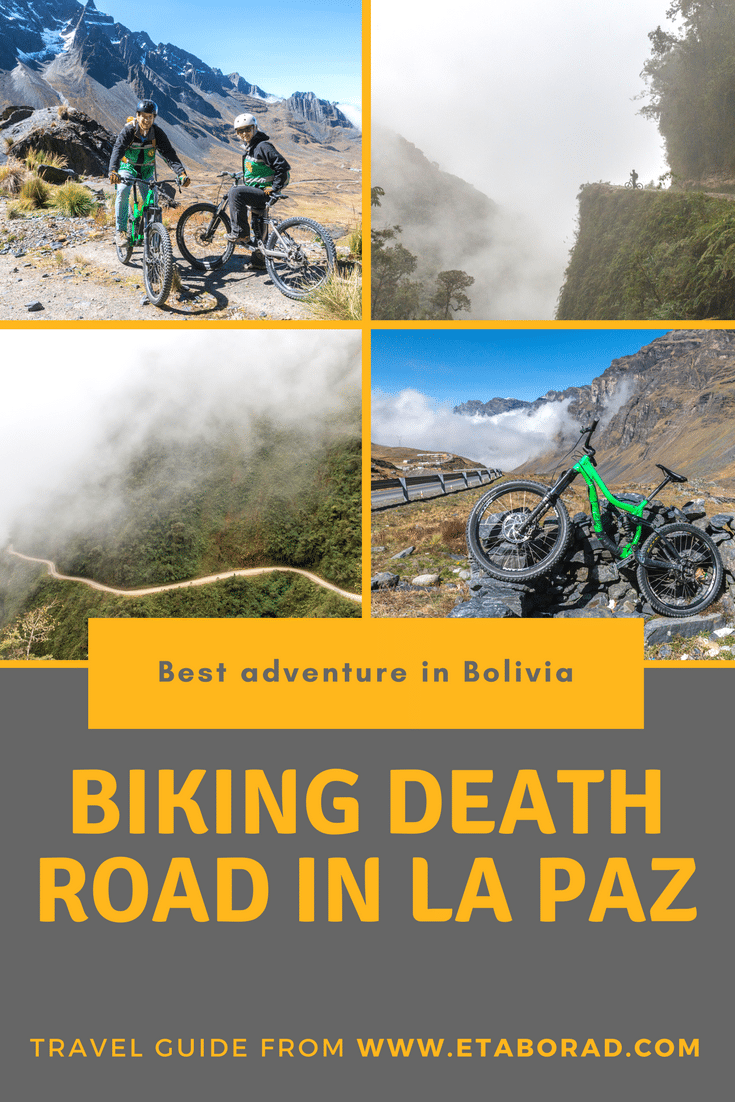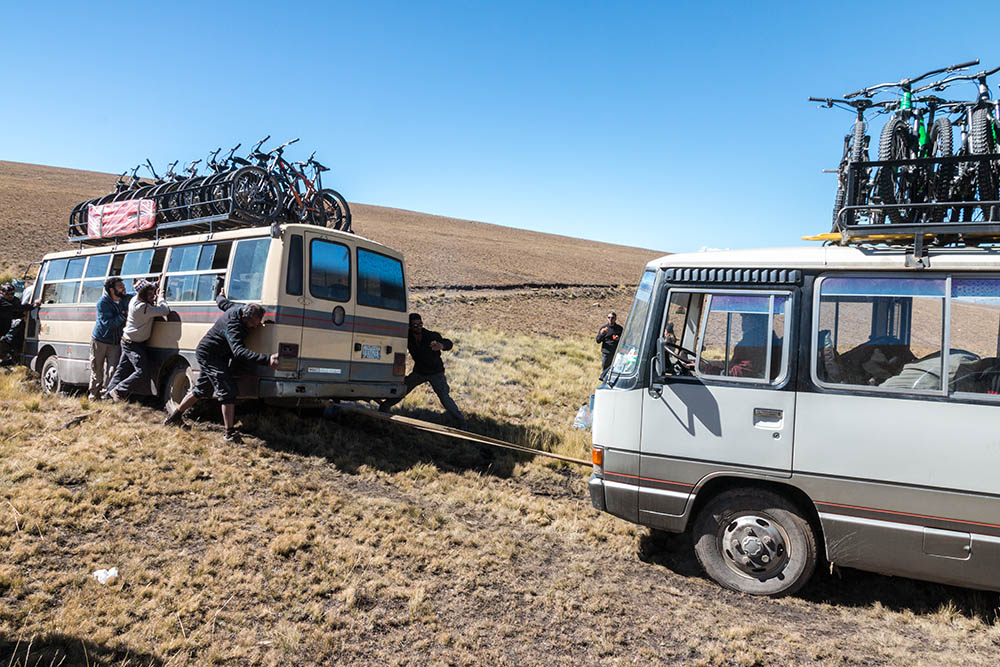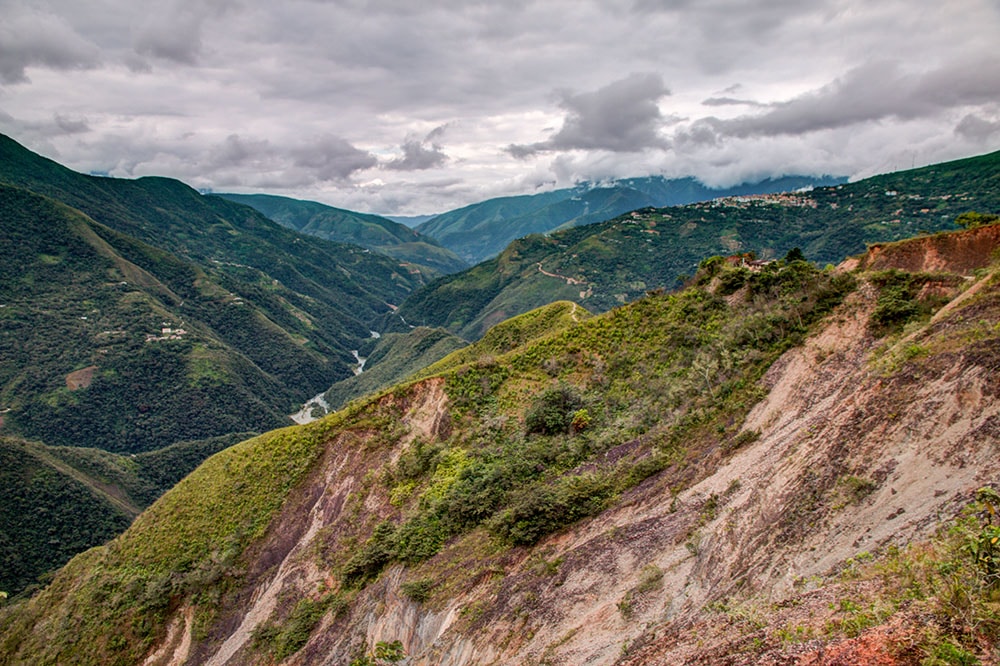The most dangerous road in the world, well-named Death Road, is located near the city of La Paz in Bolivia. The road is over 60 km long and nowadays is a popular bike path. We couldn’t resist either and simply had to ride down this road too. And we survived!
The famous Death Road was built around 1935 during the war between Bolivia and Paraguay. The prisoners from Paraguay built a road starting at an altitude of 4,650 meters above sea level, a bit less than 60 km long. At its end, the unpaved road is located at an altitude of just 1 200 meters above sea level. There is a steep and dangerous cliff on one side of the road, which runs along the entire length of it. The average number of deaths – roughly 300 people per year – makes it the most dangerous road in the world.
Check out a list of 24 Most dangerous roads in the world including this Bolivia Death Road.
The government has already built a new modern asphalt road linking the same places as the old one, which was supposed to replace the Death Road. Nevertheless, the road is still being used, although not as much as before. For its name, it has become popular among lovers of mountain biking, which has been noticed by several companies. Up to 42 companies offer bicycle rentals and provide trips to experience driving on the famous road of death. This is not entirely without risk as the number of dead tourists is estimated to be several dozens. That’s why it’s a good idea to choose the company with which you’ll set out on this adventure very carefully.
Don’t underestimate selecting the company
We chose one of the best companies – Baracuda Biking. They offer a completely professional service, helpful and experienced guides, and first-class mountain bikes and other equipment. They have an excellent rating on TripAdvisor and a very good reputation. We chose to put our trust in them and we didn’t regret it one bit. The day we were able to spend on the famous Death Road can be counted among the most adventurous days we have experienced on our travels so far.
How we almost didn’t make it to the Death Road
Our journey to the Death Road truly began very adventurously. We were supposed to meet up as usual at 7:30 AM, but because there was a strange strike happening in the streets, the company sent us an e-mail saying that we should arrive an hour earlier to be sure. But we only managed to read the message in the morning so we had to quickly rush to the meeting place. The minibus was fortunately there and waited for the others; we weren’t the only ones who were late.
Our guide was a really great guy – his name was Gustavo. Together with him, there was another guide – Fernanda. The two of them ensured our safety and the smooth proceeding of our cycling adventure. The driver was also present, of course. Our guide – Gus – explained that the locals blocked off all the roads, so no one was able to get in or out of the city. We didn’t really understand how something like that was possible, but we still hoped that we’d be able to get out of the city somehow. We already bought bus tickets to Cochabamba for the next day. When Gus heard that, he warned us that it was entirely possible the strike would last until the next day, so we might not be able to leave the city at all.
What a great start. Of course, there were barricades on the roads so we couldn’t get past. But our driver was creative and decided to try a side road, which he thought might not have been blocked off. It was a bit of an off-road because it was full of potholes and we even had to cross a river or a creek occasionally. Behind us, several other minibuses with bikes on their roofs were driving together. It was clear to us that competing cycling companies also wouldn’t want to give up so all the buses met up on this road. However the further we drove, the worse the quality of the road was; it was clear that we couldn’t continue this way. There was a long discussion on the drivers and guides from other cars started arguing with each other that they would bribe the strikers to let us through. We just sat in our car tensely and waited for what would happen next. Gus told us after that there was a very poor chance we would be able to get through at all. He assured us that if we weren’t able to get out of La Paz that day, the company would, of course, refund us our money.
Unexpected adrenaline detour
Just when we were almost certain we would be returning home that day, a ray of hope came shining through. One driver knew a different road that was usually devoid of police patrols. However, we didn’t know what kind of road it would be. It was necessary to drive over an entire mountain, so the road rose steeply to the very top of the mountain along its edge. There was a steep cliff on the side of the road so a good half of the passengers on our bus was slightly terrified.
When we finally got through the worst part and found ourselves on a flat piece of land, we saw a minibus stuck in mud in front of us. The car was trying to get around a muddy and slushy part of the road, but its wheels got stuck in the mud a little further down. Our driver immediately jumped out of the car and started helping out. Later, it was explained that the driver was also the owner of those two vehicles and he rented them out to the companies. That’s why it was understandable that he was so desperate to get the vehicle safely back on the road.
Car stuck in the mud
They connected the two cars with a strong rope, but our minibus wasn’t strong enough to pull the other car out. And that was the start of a very long debate and many attempts to somehow free the car. Because the vehicle in front of us was full of Israeli travellers – who have compulsory military service in their country – they immediately took command of the situation. It wasn’t that easy of course because the Bolivian drivers didn’t like some of their suggestions, so the result was a lengthy and heated discussion. We just simply waited and asked ourselves whether the damn car would ever be pulled out of the mud. It was already almost midday and we still weren’t there. Gus told us that we still had enough time to ride through the entire Death Road; we just wouldn’t have much time for the promised swimming pool. All of us agreed that we weren’t there because of a swimming pool so we wouldn’t mind at all.
After about an hour and a half, the minibus was finally pulled out. We were all overjoyed by this development. Finally, we were able to continue our trip and leave those bossy Israelis behind us; they were still arguing about whether it made sense to continue the journey or if they should just turn back. It was clear to us though. After we managed to overcome so many obstacles no one wanted to give up. In less than twenty minutes, however, we encountered a truck stuck in a mud. It had its entire right wheel stuck in a river. Oh no, not again! Fortunately, the driver was very skilful and managed to manoeuvre the vehicle back on the road fairly quickly. And then we finally arrived at the main asphalt road that was supposed to get us to the Death Road itself. Because we were actually quite hungry already, we received a promised snack and Gus also gave us helmets, gloves, and jackets.
Finally on the bikes
The Death Road itself is exactly 56 km long and is preceded by a beautiful new asphalt road with stunning views of the surrounding area. Although we had a significant delay, we decided to drive down a part of it. Gus showed us our mountain bikes, explained how to use the brakes and all the security features. We got a bottle of water to put inside our jackets and could finally drive all the way down.
The air was very cold, but the sights were spectacular. The driver of the minibus followed us at a slow pace, so we were able to leave all of our stuff in the car. Gus and our second guide took care of our safety the whole time. One of them was always ahead with the fastest ones and the other went last, closing our group. During the trip, they both took many photos and the very next day we received a bunch of them right into our e-mails.
When the asphalt road ended, we drove a bit further by the minibus before we reached the altitude of 4,650 meters above sea level and stopped in front of the Death Road sign. Unfortunately, the fog was pretty thick, so Gus lent us huge trousers that we pulled on top of our own. Gus explained that we were supposed to drive on the left side of the road. Yes, exactly, the one where the cliff was. The reason is that when the drivers pass each other, the ones on the left are able to watch their own wheels on the edge much better. He told us that it was possible we would encounter another vehicle, in which case he would whistle very loudly. He explained probably all possible alternatives of what could happen to us, what should we watch out for and how to act in certain situations – probably about half of our group was utterly freaked out by his descriptions. He also told us that we would drive through the really dangerous sections on the right side of the road so that we wouldn’t risk falling over the edge of the cliff.
The Road full of crosses
When we got on our bikes, everyone rode very slowly and carefully at first. The fog was really thick, so the huge cliff wasn’t visible at all. All of us drove in line behind each other like a snake and stopped at interesting locations. Along the way, we passed many crosses and after a while, when one got over the whole thing, it was a lot of fun. The cold air swirled around our ears and one had to constantly think of how many lives were lost on this road.
In interesting places, Gus told us who died and how, who fell where and how, and where did Top Gear film their famous scene. He always told us what the next section would be and how to pass through it, so that we wouldn’t endanger ourselves or others. As we descended lower and lower, the air started to warm up and we slowly began to shed our layers and layers of warm clothes. We passed through several rivers and one time even a waterfall. We took pictures above the cliff and slowly began to leave the fog behind us. On the road, we paid a toll twice, which altogether cost us around 50 Bolivianos. At the end of the road, we passed stray dogs, small children, and little houses.
When we were nearing the end of the road, we had to conquer a small hill. Our final destination was in the rainforest, with a swimming pool and a gorgeous restaurant. Because it was already getting dark, we didn’t have enough time for the swimming pool, but we didn’t really mind. All of us starving cyclists immediately rushed towards the table. The dinner was served buffet style and it was really delicious. We recommend paying a bit extra for the scrumptious homemade cheesecake. During the meal, Gus told us about the cycling accidents that he personally had on the Death Road. We were very grateful that no such thing happened to us. Especially when he said that an accident happens at least once a month. After dinner, we got into the car for our three-hour journey back to La Paz. Everyone fell asleep during the first minute or so and we arrived at our destination after dark.
We would recommend Barracuda Biking especially because of their high professionalism. Although we had to face unexpected problems at the begging of our trip, in the end, we overcame them all. Neither the driver nor the guide gave up and they did everything they could to ensure that we would be able to experience the ride through the famous Death Road. Gus was very likeable and perfectly natural. That day we got pretty lucky and our group was full of really great people, so we enjoyed everything very much.
Contact
Tel: +591 2 2310176
Website: www.barracudabiking.com
Email: info@barracudabiking.com
Address: #971 Linares St., Office 5, Between Sagarnaga & Tarija
Tripadvisor
Thanks to Barrakuda Biking for support during our visit to Bolivia. All our views are based on our own experience.
Liked this post? PIN IT FOR LATER!!




















I am a chicken. I am not sure I can do this. I think it would be more scary because of the account of who died and how. Wow, they know all that. The scenery is beautiful though. And, I like when tour end up surpassing expectations. #wkendtravelinspiration
Most people died there when it was the main road and there were lots of cars and buses. Since then, only a few people have died;) And, in fact, it’s not as dangerous as it may seem like a video.
Goodness, what an adventure to get yo your main adventure! That Death Road couldn’t possibly be named better! Thanks for linking up with #TheWeeklyPostcard!
Thank you, I was one of my dreams to ride a bike there 😉 And probably I enjoyed it more than visiting the Salt Flats at Uyuni…
What! This was such a crazy adventure. So glad that you managed to overcome the transport issues and do the biking in the end. The road does look very scary – looks like the railings are quite low and at some parts there aren’t even any! I’d definitely be up for it though 😀 sounds like an unforgettable experience. do you need to be an experienced cyclist to do this?
Usually, there are no railings because it would reduce the width of the road… You don’t need any experience on the bike, Good agencies will take care of you perfectly. I was driving very fast (the video is taken by me), but Eva was slow behind because she didn’t have big bike experience.
Wow what an adventure! I don’t think I have the courage to do this, but it does really look amazing. I guess I will just stick to watching your video! Thanks for sharing on #TheWeeklyPostcard
The most dangerous on this adventure is the name of the road;) In fact, if you follow the safety instructions and you pay for a good company it’s safe;)
Hi this seems like an amazing and harrowing adventure, and I really enjoyed reading about it, that is until you included the part about the bossy Israelis. I wish you could have left that derogatory statement out, as I’m not sure how it benefited the story. #theweeklypostcard
You’re right, it’s not important in the story that they were from Israel. However, it is not written anywhere but unfortunately, we have stayed there for a long time. All the time, everyone was arguing how to pull the stuck car… We will try to rewrite it, to avoid of blaming travelers from Israel.
It such a beautiful trip isn’t it? We did a couple of years ago and like you were very careful about which company we went with. We chose Gravity. We really enjoyed our trip with them. We didn’t have as much as an adventure as you in escaping La Paz, but am not all surprised! Bolivia is not the most predictable of countries – here’s our overview – http://2britsabroad.blogspot.co.uk/2014/05/the-worlds-most-dangerous-road.html #theweeklypostcard
Yes, Gravity is probably the best company and also the most expensive. On the way, we met cars from Gravity as we avoid the roadblocks. I really like the photos you have on the blog 🙂 I noticed you had a similarly foggy weather like us.
I like that the tour company explained each section and how to navigate it. Sounds like the trip to the start point was as much of an adventure as the ride itself.
Hi Rhonda, yeah, the company really cares about the security of the clients, so they manage all trip very professionaly. I was glad we had a really great guide who made this trip great.
Quite an adventure, but not my cup of tea. A couple of years ago I took a downhill biking trip (not as aggressive as yours!) and had a pretty bad fall that I ended up with a crack in my knee cap. Seeing how difficult your trip was, I have to say that I’m amazed that you dared take this chance. But it was beautiful, I bet.
Hi ANda, yeah I understand this is not for everyone and after your experience you wouldn’t probably like it. We were extra careful and also scared on the beginning and luckily nobody was hurt. But we like to overcome fear 🙂